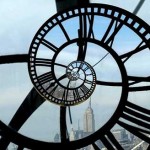Daylight Savings
March 2, 2012 by staff · Comments Off on Daylight Savings
Daylight Savings, You might wish Spring Break would stick around longer than a week. On the bright side, all the campus clocks should be set to the correct time when you return.
Daylight Saving Time begins March 11 at 2 a.m. So the clocks on campus (and your own clock, if you don’t want to be late for class) must be set an hour ahead.
The Power Plant Division used to readjust the clocks every 24 hours using a campus-wide bell system, said Mike Thomas, the maintenance and construction superintendent, in an email. However, that system was done away with sometime in the last five to 10 years.
The PPD still sets the memorial clock outside the O’Connell Center and the automated clocks that have been installed in some buildings, but each department is now responsible for setting its own wall clocks.
In the Reitz Union, most of the clocks are automated, according to John Duncan, the operations manager.
He said, “I know there’s one battery-operated clock in the Welcome Center, and I’m usually the one to get up and spin the little dial.”
Day Light Savings
November 4, 2011 by staff · Comments Off on Day Light Savings
 Day Light Savings, Daylight saving time ends on Sunday as “backward” and set the clocks back one hour. This is also a good time to review the things that keep us safe and ready for emergencies.
Day Light Savings, Daylight saving time ends on Sunday as “backward” and set the clocks back one hour. This is also a good time to review the things that keep us safe and ready for emergencies.
Smoke Detectors – Check and replace batteries if necessary and make sure your home devices are functioning properly. The U.S. Consumer Products Safety Commission estimates that about 16 million households in the country with smoke detectors that do not work. In most cases, the batteries are dead or missing. Nearly 2,700 people die and more than 15,000 are injured each year because of fires that began at home.
Carbon monoxide (CO) – Make sure you have CO detectors in your home. According to the Centers for Disease Control, carbon monoxide is the leading cause of accidental poisoning deaths in the United States, with more than 20,000 people visit the emergency room and about 500 die each year from exposure to the gas .
In addition, all homes and duplexes in Wisconsin are required to have carbon monoxide detectors. The new Wisconsin law requires that the detectors on each level of the house including the basement, but not the attic or storage areas. Any home that requires a building permit should have CO detectors connected directly to the electrical service with battery backup. Existing buildings can be used independently of detector batteries.
Emergency Kits – Everyone should have a basic emergency kit in your home with supplies such as food and water for you and your family for at least three days. Other elements such as a battery or crank radio, flashlight and first aid kit should also be included. Summertime is a perfect time to get a kit – and if you already have a kit to check that food and other items that are not near or beyond their expiration date.
For more tips on how to prepare yourself and your family, please visit our website: http://readywisconsin.wi.gov
Information on how to get a kit and a plan for when disaster strikes.
Daylight Savings 2011
September 8, 2011 by USA Post · Comments Off on Daylight Savings 2011
 Daylight Savings 2011, This is the time of year when everyone starts to wonder, when is supposed to “fall back” for daylight savings. It is autumn, after all. Should not we all be banging your head against the steering wheel, trying to remember how to change the timers time our car back soon? Hell, I have watches that have not “come forward” which can only be reused once the great swicheroo happens.
Daylight Savings 2011, This is the time of year when everyone starts to wonder, when is supposed to “fall back” for daylight savings. It is autumn, after all. Should not we all be banging your head against the steering wheel, trying to remember how to change the timers time our car back soon? Hell, I have watches that have not “come forward” which can only be reused once the great swicheroo happens.
All business can be confusing. Especially after the government extended a month in 2007. According to the Energy Policy Act of 2005, DST begins at 2 AM on the second Sunday in March and ends at 2 am on the first Sunday in November. In 2011, it will be November 5.
Daylight Saving Time is observed in most of the United States. If you live in Hawaii, American Samoa, Guam, Puerto Rico, the Virgin Islands, or most of Arizona, however, do not bother to watch exchange. If you’re wondering how only the “majority” Arizona may be the summer time, the Navajo Indian Reservation maintains local daylight saving time, even though the rest of the States’ decision to avoid it.
Basically, it’s a wonder that none of us knows what time is it at all.
So why are we going to all this trouble to change our clocks back and forth during the year? DST plans to save energy that gives us more in the afternoon and evening sunlight. If it really does is much debated.



